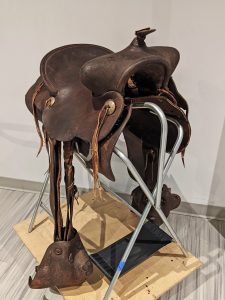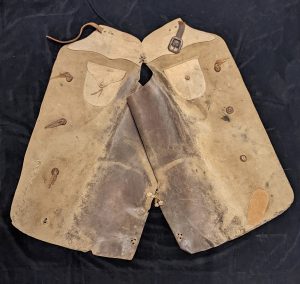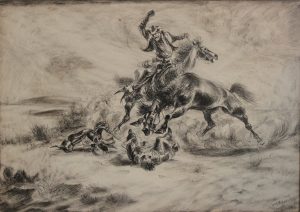
Texas Brush Country and Vaqueros
By Bruce M. Shackelford, Curator of Texas History, Witte Museum
Vaqueros and cowboys know the land where they work. Some of the best-known and most difficult working lands in Texas are called the “brush country.” The name refers to a large area of Texas and Northeastern Mexico known to cattle workers nationwide. Ricardo Beasley documented the area and the story of the vaqueros who lived there as his life’s work.
The brush country covers as much land in Mexico as it does in Texas and the densest areas of the thorny brush thickets are near Soto La Marina in Northeastern Tamaulipas. The first European to cross the landscape of the brush country and later describe the place was Spaniard Cabeza de Vaca (appropriately meaning “head of a cow”) between 1529 and 1535. He traversed the area from east of the Guadalupe River and west across most of South Texas. He found areas that were forests of cactus and thorn brush with narrow trails following through the brambles. For thousands of years the indigenous people de Vaca encountered lived in the brush country and utilized its natural characteristics to their advantage.
The brush country is not all dense brush as the name leads one to believe. The landscape is often open grassland savannah of buffalo grass, called buffelgrass in the Rio Grande valley, bluestem and many other grass species interspersed with dense areas of thorn brush and a variety of cacti. Areas near the South Texas Gulf Coast have stretches of sand resembling African deserts with high sand dunes and almost no vegetation. To the northeast the brushy areas become greener and lead into the forested areas near the Guadalupe River and Sandies Creek, two major Texas watersheds in the Coastal Bend.
Some of the densest thickets in Texas run between Hebbronville and the Rio Grande River. Turning off the paved roads onto the sandy loam trails, dense brush hugs your pickup truck and seeing more than a few feet into the thicket is difficult. Close to the Rio Grande River the country suddenly opens into grassy fields as you near the international boundary. In the days before fences, wild range fires cleared large areas of brush. Mesquite, prickly pear (opuntia) cactus, catclaw, guajillo, huisache, whitebrush and blackbrush, cenizo and small live oak and post oak trees comprise the plants in the dense brush. Wildflowers abound in a wet springtime.

Once a place inhabited by wolves and rattlesnakes, the landscape still provides a home to some of Texas’ rarest and least seen inhabitants, from ocelots to coatimundi. White-tailed deer grow large and healthy from the minerals leaching from the ground into the grass they consume. Javelinas (or collared peccaries) run in packs from the brush country and across the Southwestern United States and northern Mexico. Snakes of all kinds live under the heavy brush and cactus as well as a variety of insects.
Two introduced species, cattle and horses, changed the South Texas brush country forever as well as the lives of the people who lived there. From the time the first Spanish traversed the area, escaped horses bred rapidly and the place was marked on maps as the “Wild Horse Desert.” Cattle, bred in the desert regions of Spain, also adapted well to the ecology of the brush country and developed characteristics like long horns for defense against predators and an immunity to fever transmitted by ticks in the area that killed breeds from other countries like England and Scotland.
The handlers of the animals, Spanish vaqueros, adapted centuries-old skills to work cattle in the brush country. The ability to stand on the saddle was a normal practice by vaqueros to see over the heavy brush. Whistle signals were used throughout the region and by the mid-1800s whistling and whistles had spread throughout Texas coastal bend ranches. The animals even responded to some whistles. A well-trained horse would return to a vaquero who had been thrown or fallen from the saddle.
Ropes in the brush country, often rawhide and 50-80 feet long, became shorter for working in heavy brush. Thirty to thirty-five foot ropes became more common and rawhide changed to spun maguey cactus fiber for better durability and strength.

South Texas saddles were heavy and stout to stand up to hard use. The stirrups were covered with tapaderos on the front to keep them from hanging on low limbs and in heavy brush. Tapaderos protected the riders’ boots from the constant wear from the brush. The saddles often had a breast collar on the front of the horse and a crupper in the rear to anchor the saddle and rider from the heavy jolts of catching a running bull on a rope tied around the saddle horn.
Vaqueros’ dress required for the brush country included chaparreras or chaps covering the rider’s legs. Vaquero gear chaps spread across Texas and northward to Canada. Long sleeve shirts and wide-brimmed hats kept the sun off vaqueros and shielded them from thorny tree branches. Leather gloves were always worn to defend hands from brush impact as well as fast-moving ropes. In the early Spanish era, shoes were worn with the chaparreras but by the 1820s boots were replacing shoes. The dress and riding equipment of the brush country vaquero is still used today where cattle are raised.
By the late 20th century, cattle ranching in South Texas changed. There were few vaqueros practicing the finely tuned skills of their ancestors. Large machinery cleared the heavy brush to open up savannah for grazing. Feedlots were more common than open-range grazing operations as the taste for beef changed over 200 years. Wildlife has been elevated to hold a greater importance than cattle as the grazing diminished. The wild beauty of the Texas brush country has always been a place of surprise and will continue to be. Driving through the open grasslands, one sees a variety of prize cattle. Then, a turn into heavy brush can reveal a pack of javelinas, quail and deer. Vaqueros are rarely seen today and their skills are fading into the past.

Ricardo Beasley’s drawings and musings tell the passing story of the Texas brush country and the vaqueros who called the place home. Beasley captured the skill, terror and humor in a working day of a vaquero, all testaments to living in the brush country of the past.
Witte Museum Members Magazine | Fall 2022
Header photo courtesy by Wyman Meinzer. Courtesy of East Foundation